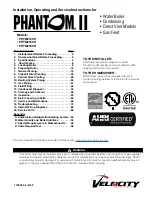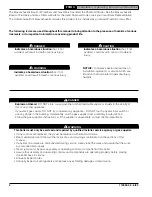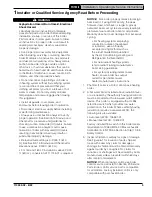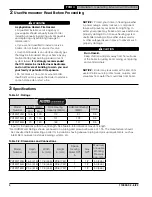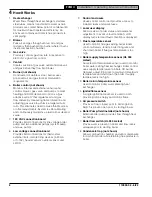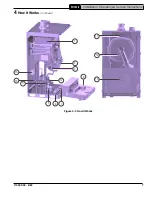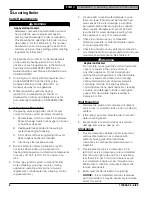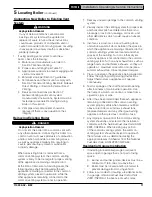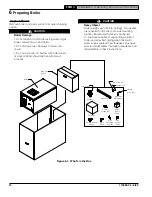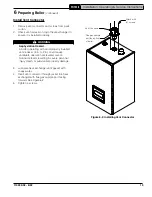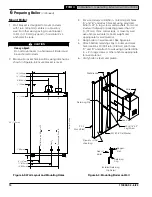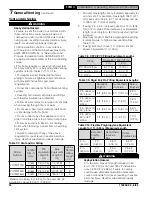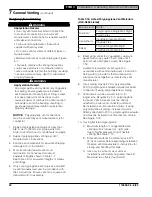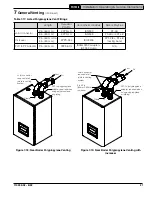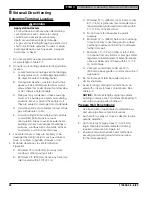
8
110332-02 - 6/22
PHTM II
Installation, Operating & Service Instructions
5
Locating Boiler
Code Requirements
WARNING
Asphyxiation Hazard.
Adequate combustion and ventilation air must
be provided to assure proper combustion
and to prevent damage to boiler components.
Provide ventilation openings into boiler room as
described in "Air for Ventilation" in this manual.
Combustion air must be brought to boiler from
outdoors using an intake piping system meeting
requirements in Section 7.
!
2. All wiring must comply with National Electrical
Code ANSI/NFPA 70 (in the USA) or the
Canadian Electrical Code CSA C22.1 (in
Canada) and any local regulations.
3. Where required by authority having
jurisdiction, installation must conform to
Standard for Controls and Safety Devices for
Automatically Fired Boilers
, ANSI/ASME CSD-
1.
Location Considerations
1. If replacing an existing boiler, check for and
correct common system problems including:
A. System leaks, which can result in premature
heat exchanger failure from oxygen corrosion
or hardness deposits
B. Inadequate freeze protection resulting in
system freezing and leaking
C. Dirt or debris left in existing piping if it has not
been properly flushed or cleaned
D. Incorrectly sized expansion tank
2. Boiler is listed for indoor installation only. Do
not install where boiler will be exposed to
freezing temperatures or ambient air temperatures
in excess of 104°F (40°C). Do not install in an
attic.
3. Protect gas ignition system components from
water (dripping, spraying, rain, etc.) during
appliance operation and service (circulator
replacement, condensate trap cleaning, control
replacement etc.).
4. Locate boiler to avoid water damage in case
there is a leak. If boiler must be located in an
area sensitive to water damage, install drain
pan underneath boiler and pipe to a suitable
drain location. Manufacturer will not be held
responsible for water damage resulting from
this appliance or any of its components.
5. Check for and remove any combustible
materials, gasoline, or other flammable liquids
from area around boiler.
6. Check for and remove any potential combustion
air contaminants from area around boiler and area
around vent/air termination. See Table 5-2.
WARNING
Explosion Hazard.
Do not store or use gasoline or other flammable
vapors or liquids in the vicinity of this or
any other appliance. Do not install vent/air
termination where gasoline or other flammable
vapors or liquids are stored. Avoid locating
vent/air termination near chemical products
containing chlorine, chlorine based salts,
chloro/fluorocarbons, paint removers, cleaning
solvents, and detergents. Boiler could ignite
vapors from flammable liquids resulting in
explosion or fire.
!
Wall Mounting
1. Wall must be plumb and comprised of cement,
brick, block, or wooden studs on 16 in. (406 mm)
centers.
2. If flooding is possible, elevate boiler to prevent
water reaching boiler.
3. Ensure boiler location minimizes risk of water
damage from valves, pumps, etc.
Clearances
1. Provide clearances between boiler jacket and
combustible material in accordance with
authority having jurisdiction. Minimum
clearances to combustible material shown in
Figure 5-1.
2. Provide practical service clearances. 24 in.
(610 mm) service clearance are recommended
from left side, right side and front. If providing
less than 24 in. (610 mm) front clearances are
recommended, ensure access through a door.
Minimum 6 in. (150 mm) clearance required to
remove side panels.
3. Boiler must not be installed on carpeting.
1. Installations must conform to the requirements
of the authority having jurisdiction or, in the
absence of such requirements, to the
National
Fuel Gas Code
, ANSI Z223.1/NFPA 54, or
Natural Fuel Gas and Propane Installation Code
,
CAN/CSA B149.1.
NOTICE:
If recommended service clearances
are not provided, it may be necessary to remove
boiler for service.

